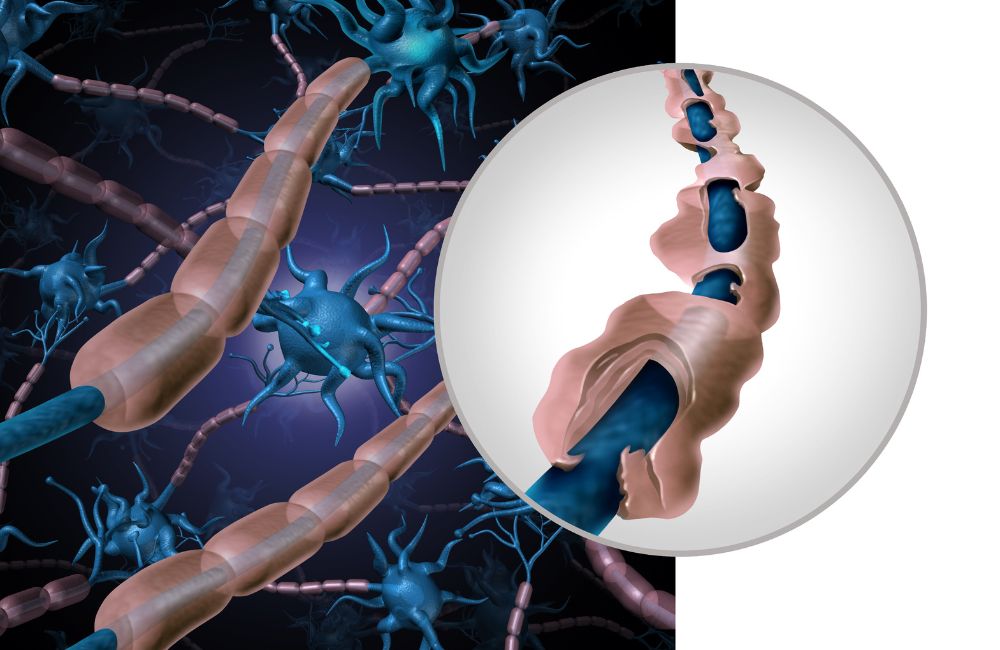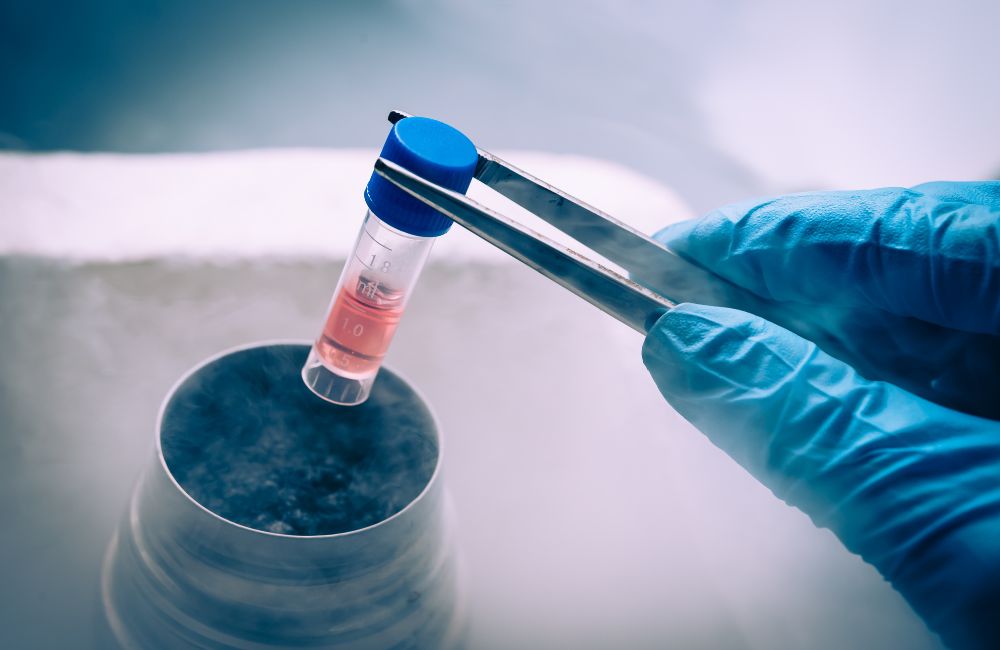
Stem cell therapy offers a promising new treatment for individuals with Multiple Sclerosis (MS), a chronic autoimmune disease. This therapy harnesses the regenerative potential of stem cells to repair and replace damaged tissues, potentially halting the progression of the disease and improving patients’ quality of life. Study shows that 40.4% of MS patients experienced improvements after undergoing MSC therapy. Preparing for stem cell therapy involves several important steps to ensure the best possible outcome.
Table of Contents
Key Takeaways
What is Multiple Sclerosis (MS)?
Stem Cell Therapy for MS
Initial Consultation and Assessment
Steps to Prepare for Stem Cell Therapy
The Day of Treatment
Post-Treatment Care and Recovery
Frequently Asked Questions
| Key Takeaways ✔ Multiple Sclerosis (MS) is a chronic autoimmune disease affecting the central nervous system, causing symptoms like fatigue, muscle weakness, and vision problems. ✔ Stem cell therapy leverages the regenerative potential of hematopoietic and mesenchymal stem cells to repair damaged tissues and reduce inflammation in MS patients. ✔ Hematopoietic stem cells can reset the immune system, reducing its attack on the nervous system in MS patients. ✔ Select a clinic with experience, accreditation, and positive patient reviews to ensure the best outcomes for stem cell therapy. ✔ Optimize health through a balanced diet, regular exercise, and managing existing MS symptoms with medications and physical therapy. ✔ Be prepared for stem cell therapy’s emotional and psychological impact and seek support through counseling and support groups. ✔ On the day of treatment, expect a multi-hour process involving check-in, pre-treatment preparation, stem cell infusion, and post-treatment monitoring. ✔ Follow the doctor’s instructions for managing immediate side effects, adhere to activity restrictions, and engage in physical therapy for long-term recovery. |
What is Multiple Sclerosis (MS)?
Multiple Sclerosis (MS) is a chronic autoimmune disease affecting the central nervous system, specifically the brain and spinal cord. It is estimated that over 1.8 million people worldwide have MS. It occurs when the immune system mistakenly attacks the protective sheath (myelin) that covers nerve fibers, leading to communication problems between the brain and the rest of the body. Over time, this damage can result in the deterioration or permanent damage of the nerves. The severity and progression of MS vary widely among individuals, making it a complex condition to manage. Common symptoms of MS include:
- Fatigue: A prevalent and often disabling symptom.
- Difficulty Walking: Due to muscle weakness or spasticity.
- Numbness or Tingling: Commonly in the face, arms, or legs.
- Muscle Weakness: Often in the legs and hands.
- Vision Problems: Such as blurred or double vision.
- Problems with Coordination and Balance: This leads to an increased risk of falls.
Stem Cell Therapy for MS
Stem cell therapy is an innovative treatment approach that leverages the regenerative potential of stem cells to repair and replace damaged tissues. In the context of MS, stem cell therapy aims to rebuild the damaged myelin sheath, reduce inflammation, and potentially halt the progression of the disease.
Types of Stem Cells Used
- Hematopoietic Stem Cells (HSCs)
- Source: Typically sourced from bone marrow or peripheral blood.
- Function: These cells can develop into all types of blood cells, including immune cells. In stem cell therapy for MS, HSCs are used to reset the immune system, reducing its attack on the nervous system.
- Mesenchymal Stem Cells (MSCs)
- Source: These multipotent stem cells are found in various tissues, including bone marrow, adipose (fat) tissue, and umbilical cord tissue.
- Function: MSCs have anti-inflammatory properties and can aid in repairing and regenerating damaged tissues, making them promising for treating MS.
How Stem Cell Therapy Targets MS
Stem cell therapy targets MS through several mechanisms:
- Immune System Reset: HSCs can help reset the immune system, reducing its attack on the nervous system. This is achieved by wiping out the existing immune system and reintroducing HSCs to create a new, less aggressive immune system.
- Anti-Inflammatory Effects: MSCs possess anti-inflammatory properties that can help reduce the inflammation associated with MS.
- Tissue Repair and Regeneration: Stem cells have the potential to repair and regenerate damaged tissues, including the myelin sheath around nerve fibers, which is crucial for restoring normal nerve function.
Initial Consultation and Assessment
The initial consultation and assessment are crucial steps in preparing for stem cell therapy. They ensure that the treatment plan is tailored to your specific needs and health condition.
Choosing the Right Clinic and Specialist
Selecting the right clinic and specialist is crucial for the success of stem cell therapy. Consider the following factors:
- Experience and Expertise: Look for a clinic with extensive experience in treating MS with stem cell therapy. The specialists should have a strong background in neurology and regenerative medicine.
- Accreditation and Certification: Ensure the clinic is accredited by relevant medical boards and regulatory bodies.
- Patient Reviews and Testimonials: Check patient reviews and testimonials to gauge the clinic’s reputation and success rates.
- Technology and Facilities: The clinic should be equipped with state-of-the-art technology and facilities to perform stem cell therapy safely and effectively.
Medical Evaluation and Tests
Before undergoing stem cell therapy, a thorough medical evaluation is necessary. This includes:
- Medical History and Physical Examination: Your doctor will review your medical history and conduct a physical examination to assess your overall health and MS symptoms.
- Diagnostic Tests and Imaging: MRI scans, blood tests, and neurological assessments help determine the extent of nerve damage and guide the treatment plan.
- Assessment of Current Treatments: Evaluate your current treatments and medications to ensure they are compatible with stem cell therapy.
Steps to Prepare for Stem Cell Therapy
Proper preparation is essential for maximizing the effectiveness of stem cell therapy and ensuring a smooth treatment process.

Pre-Treatment Health Optimization
Diet and Nutrition Tips
Maintaining a healthy diet is essential for optimizing your body’s response to stem cell therapy. Consider the following nutritional tips:
- Balanced Diet: Eat various fruits, vegetables, lean proteins, whole grains, and healthy fats.
- Hydration: Drink plenty of water to stay hydrated. Proper hydration supports cellular functions and recovery.
- Supplements: Consult your doctor about supplements such as omega-3 fatty acids, vitamin D, and antioxidants to support your overall health. These supplements can reduce inflammation and support immune function.
- Avoiding Processed Foods: Limit your intake of processed foods, sugar, and unhealthy fats, which can contribute to inflammation.
Exercise Recommendations
Regular exercise can help improve your physical condition and enhance the effectiveness of stem cell therapy. Consider incorporating the following exercises:
- Aerobic Exercise: Walking, swimming, and cycling can improve cardiovascular health and stamina.
- Strength Training: Light weightlifting or resistance exercises can help maintain muscle strength and flexibility.
- Stretching and Yoga: Stretching exercises and yoga can improve flexibility, balance, and overall well-being.
- Customized Exercise Plans: Work with a physical therapist to develop a personalized exercise plan tailored to your abilities and needs.
Managing Existing MS Symptoms
Medications
Continue taking your prescribed medications to manage MS symptoms. Discuss with your doctor any adjustments that may be needed before starting stem cell therapy. It’s crucial to ensure that your current treatment regimen is compatible with the new therapy.
Physical Therapy
Engage in physical therapy to maintain mobility and reduce muscle stiffness. A physical therapist can provide personalized exercises to address your specific needs. Regular physical therapy sessions can help manage symptoms and prepare your body for the demands of stem cell therapy.
Understanding the Emotional Impact
Potential Emotional and Psychological Effects
Undergoing stem cell therapy can be emotionally challenging. It’s important to be aware of the potential emotional and psychological effects, such as:
- Anxiety: Concerns about the treatment process and outcomes.
- Stress: Managing the logistics and uncertainties of the treatment.
- Mood Swings: Due to changes in physical health and the impact of the therapy.
Counseling and Support Groups
Participate in counseling sessions or join support groups for individuals with MS. Sharing your experiences and concerns with others who understand your situation can provide valuable emotional support. Support groups can also offer practical advice and encouragement from those who have undergone similar treatments.
Setting Realistic Expectations
What to Expect from the Therapy
Understanding what to expect from stem cell therapy can help set realistic expectations. While many patients experience significant improvements, results can vary. Discuss potential outcomes and risks with your doctor to gain a clear understanding of the treatment’s potential benefits and limitations.
- Short-Term Effects: Initial improvements and possible side effects.
- Long-Term Benefits: Potential for reduced symptoms and improved quality of life.
- Risks and Uncertainties: Possible complications and varying individual responses.
Discussing Potential Outcomes and Risks with Your Doctor
Have an open and honest conversation with your doctor about the potential outcomes and risks of stem cell therapy. Your doctor can provide insights based on your specific condition and guide you in making an informed decision. Ask about success rates, possible side effects, and the expected timeline for seeing results.
Scheduling and Time Commitment
Duration of Treatment Sessions
Stem cell therapy typically involves multiple sessions over a period of weeks or months. Each session may last several hours, depending on the type of stem cells used and the specific treatment protocol.
- Number of Sessions: Discuss the treatment schedule with your doctor.
- Length of Each Session: Plan for extended time at the clinic.
Time Off Work and Daily Activities
Plan for the necessary time off work and adjustments to your daily activities. Recovery periods may vary, and you may need to limit certain activities during the initial stages of treatment.
- Work Leave: Arrange for leave from work if necessary.
- Household Help: Consider arranging for help with daily tasks and responsibilities.
Travel and Accommodation
Arranging Travel if the Clinic Is Not Local
If the clinic is not local, make travel arrangements well in advance. Consider factors such as transportation, accommodations, and any special needs you may have during your stay.
- Transportation: Book flights or arrange for other transportation.
- Accessibility: Ensure the travel arrangements accommodate any mobility issues.
Accommodation Options Near the Clinic
Research accommodation options near the clinic to ensure a comfortable and convenient stay. Look for accommodations that offer accessibility features and amenities to support your needs during treatment.
- Proximity to Clinic: Choose a location close to the clinic for convenience.
- Comfort and Accessibility: Ensure the accommodation meets your needs.
Financial Considerations
Cost of Stem Cell Therapy
Stem cell therapy can be expensive, and it’s important to understand the cost breakdown. Expenses may include:
- Consultations: Initial and follow-up consultations with specialists.
- Medical Tests: Diagnostic tests and imaging.
- Stem Cell Extraction and Processing: Harvesting and preparing stem cells.
- Treatment Sessions: Costs of the actual treatment sessions.
- Post-Treatment Care: Follow-up care and medications.
Insurance Coverage and Out-of-Pocket Costs
Check with your insurance provider to determine if stem cell therapy is covered under your plan. Be prepared for potential out-of-pocket costs, and discuss payment options with the clinic.
- Insurance Coverage: Verify coverage and reimbursement policies.
- Out-of-Pocket Expenses: Plan for uncovered costs and co-pays.
Financial Assistance and Payment Plans
Explore financial assistance programs and payment plans offered by the clinic. Some clinics may offer financing options to help make the treatment more affordable.
- Payment Plans: Discuss installment payment options with the clinic.
- Financial Aid: Look for grants or assistance programs for medical treatments.
The Day of Treatment
On the day of treatment, understanding the process and knowing what to expect can help ease any anxieties and ensure a smooth experience.
Step-by-Step Process
- Check-In: Arrive at the clinic and complete the check-in process.
- Bring necessary identification and paperwork.
- Review the day’s schedule with the clinic staff.
- Pre-Treatment Preparation: Medical staff will prepare you for the treatment, which may include blood tests, vital sign monitoring, and IV placement.
- Wear comfortable clothing.
- Follow any pre-treatment instructions provided by your doctor.
- Stem Cell Infusion: The stem cells will be administered through an IV infusion. The process typically takes a few hours.
- Relax and remain still during the infusion.
- Communicate any discomfort to the medical staff.
- Post-Treatment Monitoring: After the infusion, you will be monitored for any immediate reactions or side effects.
- Rest in a recovery area.
- The medical team will check your vital signs and overall condition.
Duration and What to Bring
The duration of the treatment session may vary, but it usually lasts several hours. Bring items such as comfortable clothing, a book or electronic device for entertainment, and any necessary medications.
- Comfort Items: Blanket, pillow, or personal comfort items.
- Entertainment: Books, magazines, or electronic devices.
- Medications: Bring any regular medications and a list of prescriptions.

Post-Treatment Care and Recovery
Effective post-treatment care and a well-planned recovery process are essential for achieving the best possible outcomes from stem cell therapy.
Immediate Post-Treatment Care
Monitoring and Initial Recovery
After the treatment, you will be monitored for a few hours to ensure there are no immediate complications. The medical team will provide instructions for post-treatment care and recovery.
- Observation Period: Stay in the clinic for a designated observation period.
- Initial Recovery: Focus on rest and hydration.
Follow-Up Instructions
Follow your doctor’s instructions for post-treatment care, including any medications, activity restrictions, and follow-up appointments. Keeping up with these instructions is crucial for optimal recovery.
- Medication Schedule: Follow prescribed medication schedules.
- Activity Restrictions: Adhere to any advised activity limitations.
- Follow-Up Appointments: Schedule and attend all follow-up visits.
Short-Term Care
Managing Immediate Side Effects
Common side effects of stem cell therapy may include fatigue, mild fever, and soreness at the injection site. These side effects are usually temporary and can be managed with rest and over-the-counter medications.
- Fatigue: Get plenty of rest and avoid strenuous activities.
- Fever: Use over-the-counter fever reducers if necessary.
- Soreness: Apply ice packs to the affected area to reduce discomfort.
Activity Restrictions and Guidelines
Follow any activity restrictions and guidelines provided by your doctor. It’s important to avoid strenuous activities during the initial recovery period to allow your body to heal.
- Rest: Prioritize rest to support your body’s recovery.
- Light Activities: Engage in light activities as tolerated, avoiding anything strenuous.
Long-Term Recovery and Rehabilitation
Physical Therapy
Continue with physical therapy to support long-term recovery and improve mobility. A physical therapist can help you develop a personalized exercise plan to address your specific needs.
- Customized Exercise Plan: Follow the exercise regimen provided by your therapist.
- Regular Sessions: Attend regular physical therapy sessions to monitor progress.
Regular Follow-Ups and Monitoring Progress
Regular follow-up appointments with your doctor are essential for monitoring your progress and adjusting the treatment plan as needed. These appointments help track improvements and address any concerns that may arise.
- Monitoring: Track changes in symptoms and overall health.
- Adjustments: Make necessary adjustments to your treatment plan based on your progress.
- Communication: Maintain open communication with your healthcare team to report any new or changing symptoms.

Frequently Asked Questions
What are the potential risks and side effects of stem cell therapy for MS?
Stem cell therapy for MS can have potential risks and side effects, including infection, immune reactions, and in rare cases, the development of tumors. It’s crucial to discuss these risks with your doctor before starting treatment.
How long does it take to see results from stem cell therapy for MS?
The timeline for seeing results from stem cell therapy can vary widely among patients. Some may notice improvements within a few months, while others might take longer. Continuous monitoring and follow-ups with your healthcare provider are essential.
Is stem cell therapy for MS covered by insurance?
Coverage for stem cell therapy varies by insurance provider and policy. Many insurance plans do not cover experimental treatments, so it’s important to check with your provider about coverage and potential out-of-pocket costs.
Can stem cell therapy cure Multiple Sclerosis?
While stem cell therapy shows promise in managing and potentially reversing some damage caused by MS, it is not considered a cure. The therapy aims to reduce symptoms and improve quality of life.
What is the success rate of stem cell therapy for MS?
Success rates for stem cell therapy in MS patients vary depending on several factors, including the type of stem cells used and the patient’s condition. Clinical studies and patient testimonials suggest varying degrees of improvement in symptoms and disease progression.

Take Action Today with BioRestore
If you’re considering stem cell therapy for Multiple Sclerosis, BioRestore is here to help. Residents of CT can trust our experienced team to guide them through every step of the process, ensuring the best possible outcomes.
Contact BioRestore today to schedule your consultation and take the first step towards a better quality of life. If you’re in CT and seeking expert care, BioRestore is your local choice for advanced stem cell therapy in CT.
Visit us today!